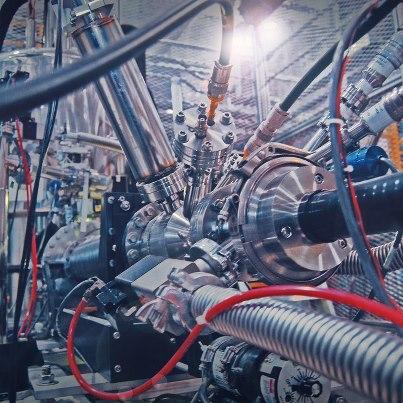

Interesting physics frequently happens at interfaces---either between fields of science or between physical media like materials or particles.
TRIUMF's Centre for Molecular and Material Sciences (CMMS) recently achieved a breakthrough in the area of material interfaces. There is evidence that the interfaces in a multilayer sandwich made up of two insulating and non-magnetic materials (SrTiO3 and LaAlO3) can be magnetic, conducting, and even superconducting at very low temperatures. It's like putting together a couple of pieces of dry bread and suddenly finding you have a Dagwood sandwich with all of the fixings!
One of the challenges in this case is that it is difficult to study properties of buried interfaces experimentally (as in, if the slices of bread are thick, how do you verify what's in the inside of the sandwich?). The β-NMR facility in TRIUMF's ISAC-I uses a low-energy beam of spin-polarized radioactive ions to probe thin films, multi-layers, and near-surface regions (depths ≤ 300 nm) (http://bnmr.triumf.ca).
β-NMR is an exotic form of nuclear-magnetic resonance (NMR) in which the nuclear-spin-precession signal is detected through the beta decay of a radioactive nucleus. The spin-relaxation rate of implanted lithium-8 are sensitive to the fluctuating electronic moments at the SrTiO3/LaAlO3 interfaces. Zaher Salman (PSI) and coworkers were able to detect for the first time the appearance of magnetism in such multilayers. The extreme sensitivity of β-NMR enabled this measurement; the magnetism in these samples is more than 1,000 times smaller than that in iron and is not detectable by other techniques! Additionally, by studying samples with different thickness of LaAlO3 layers, it was discovered that the magnetism disappears at or below a minimal/critical thickness of 5 unit cells of LaAlO3.
These measurements demonstrate the potential of a new form of "chemistry", where one can create new devices with certain properties that do not exist in the original materials used to build them. The particular example of interfaces between SrTiO3 and LaAlO3, where the coexistence of magnetism, conductivity, and superconductivity provides exciting example of this new field.
Scientists are always hesitant to speculate, but these results start to support the notion that we will soon be able to completely program and generate a thin sandwich of materials that produces behaviours mimicking individual preferences: thin-materials displays that not only show multiple outcomes but also change behaviour to influence what we as human beings will do next.
Powerful self-interacting environment are the future. Don't be surprised if these materials show up around you soon!
The new paper is available at Phys. Rev. Letter. 109, 257207 (2012).
-- by Iain McKenzie (CMMS Facility Scientist, TRIUMF) and Zaher Salman (Research Scientist, PSI)
